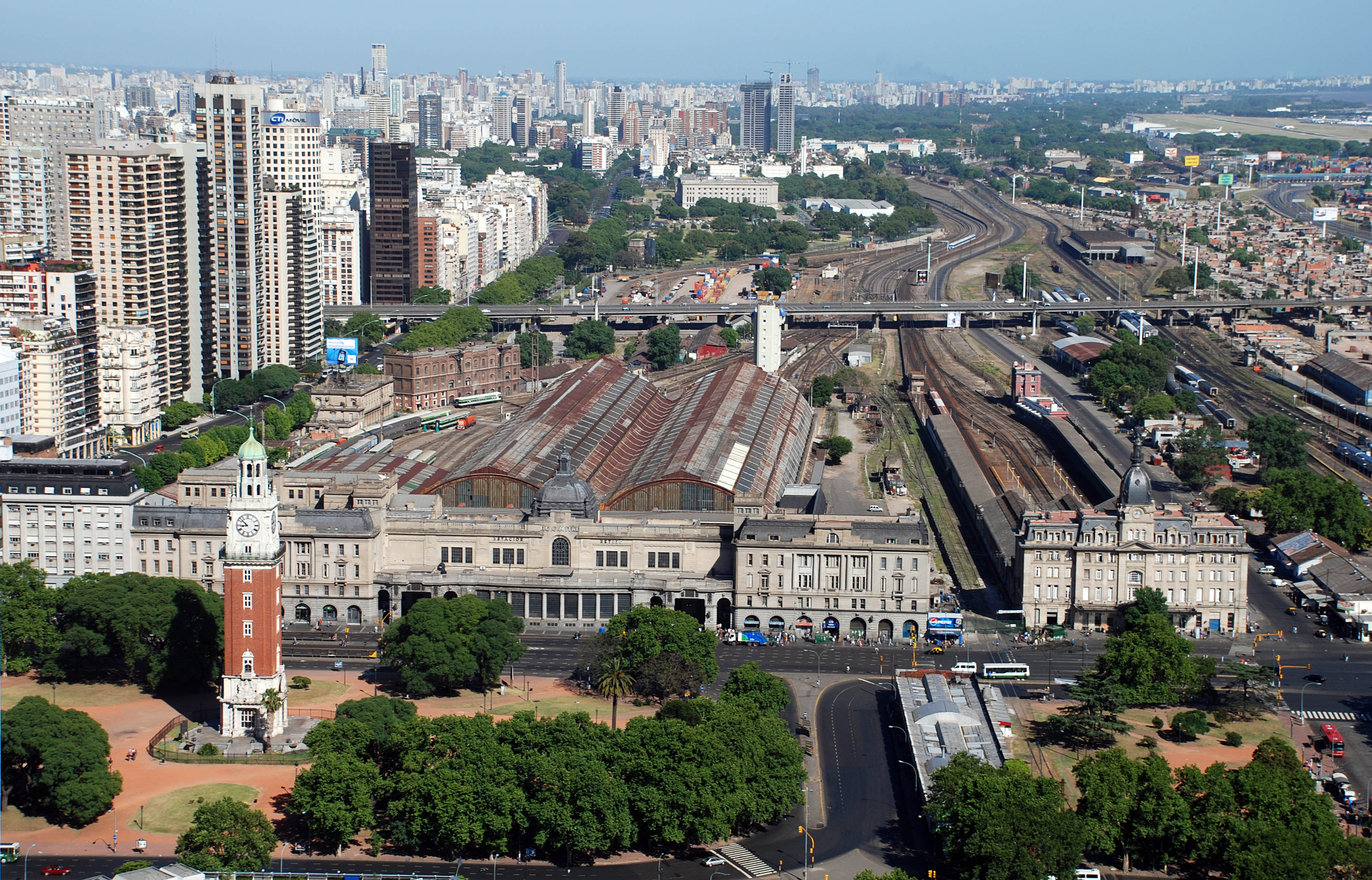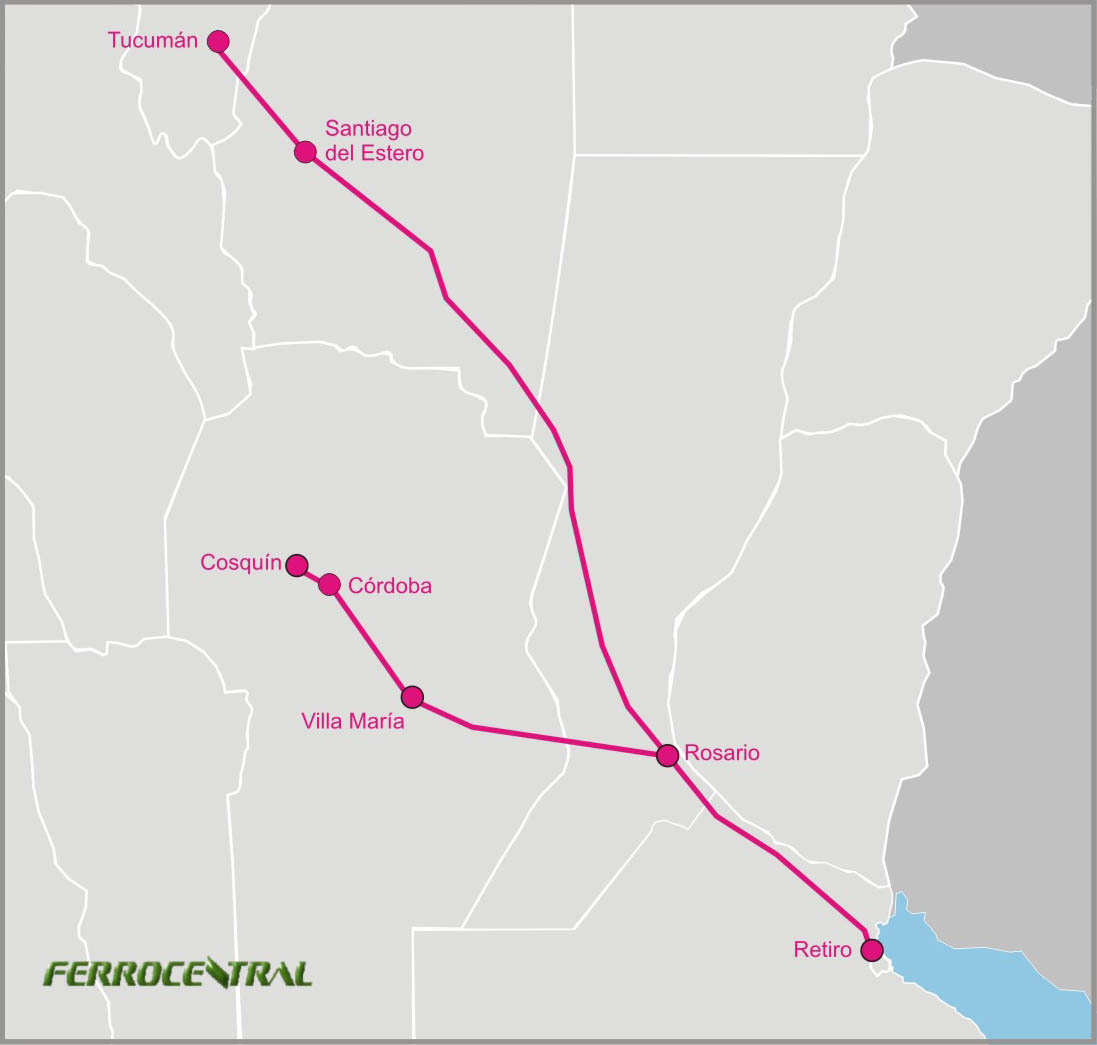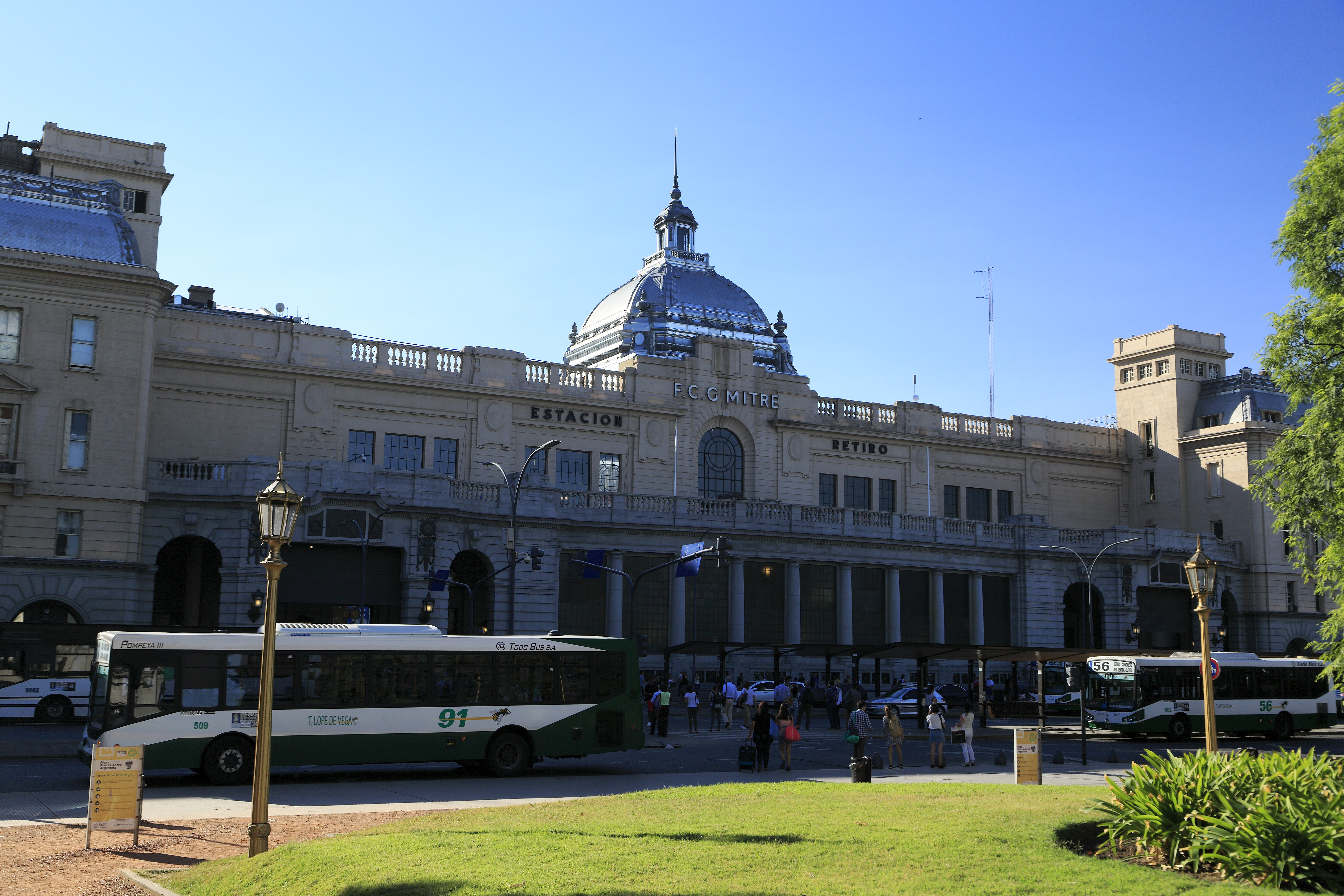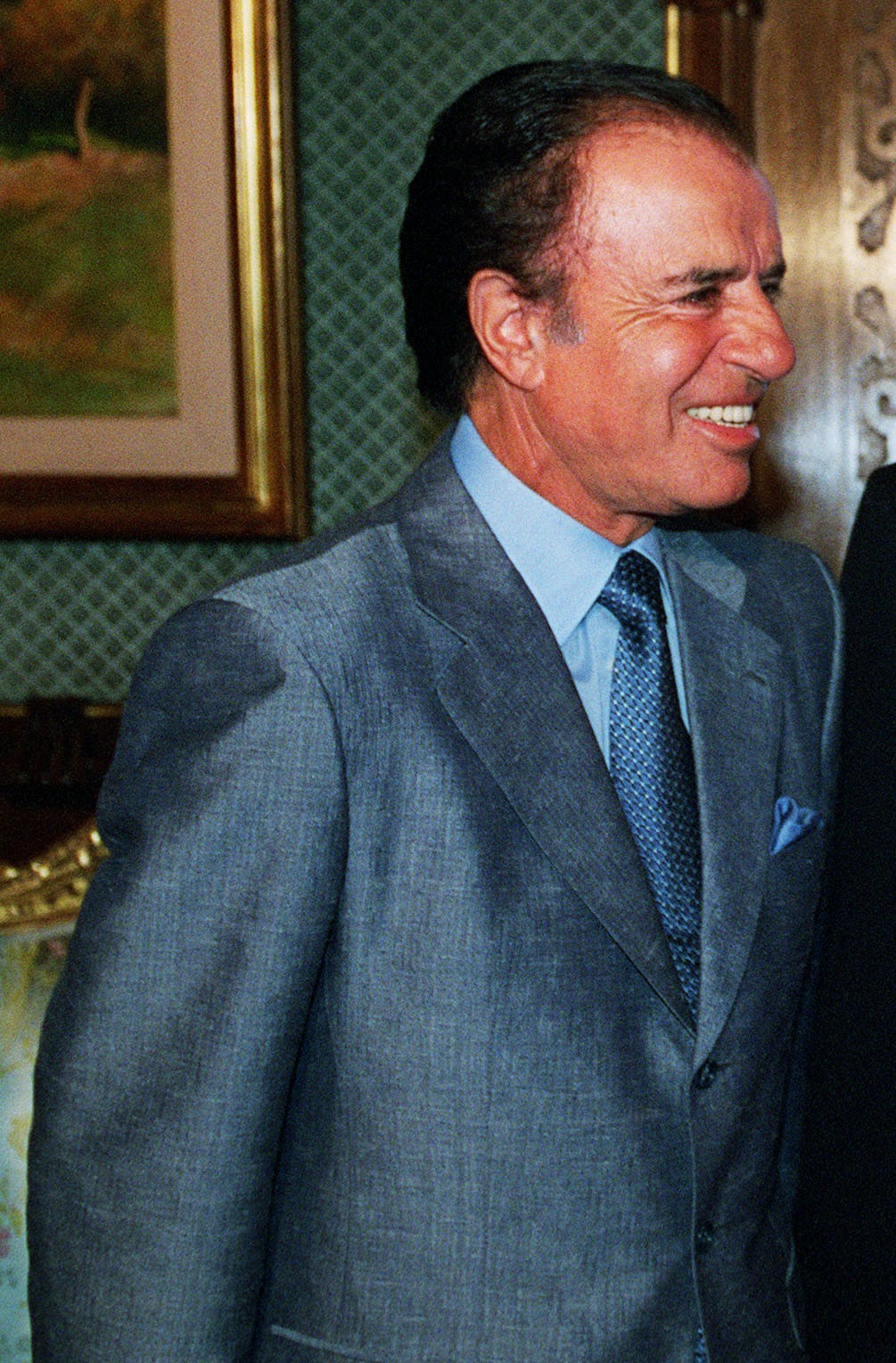|
Rosario Norte Station
Rosario Norte is a railway station in Rosario, province of Santa Fe, Argentina. It is located on Aristóbulo del Valle Avenue, at the junction with Callao St., north of the city centre, in the neighbourhood known as Barrio Pichincha. The station, part of the Ferrocarril Mitre network, is currently operated by two companies, State-owned Operadora Ferroviaria (passenger services) and private Nuevo Central Argentino (NCA) (freight). History The station was terminus of the Buenos Aires and Rosario Railway (BARR) company. The railway line was opened in 1885 and was the first to join Rosario and Buenos Aires (about 300 km south-southeast). From Rosario Norte the line continued to the northwest, crossing several provinces of Argentina to reach Tucumán. In 1908, after the merging of the BARR and the Central Argentine Railway companies, the station was set aside to handle long-distance and express services. Around 1935–1940, a few years after the "golden age" of the Argentine railwa ... [...More Info...] [...Related Items...] OR: [Wikipedia] [Google] [Baidu] |
Buenos Aires And Rosario Railway
The Buenos Aires and Rosario Railway (BA&R) was a British-owned railway company that built and operated a broad gauge railway network in Argentina, where it was known as the "Ferrocarril Buenos Aires y Rosario". Originally thought as a line from Buenos Aires to Campana, it then extended to the provinces of Santa Fe, Santiago del Estero, and Tucumán. The BA&RR also took over the Santa Fe and Córdoba Railway in 1900. The company operated until 1908, when it was acquired by the Central Argentine Railway which took over its services. History Preliminary projects By the 1870s, people from Littoral zone that came to Buenos Aires by train, had to navigate on Sarmiento River to Tigre, where the Buenos Aires Northern Railway ("Ferrocarril del Norte de Buenos Aires") carried them to the centre of the city. Many times the river was not able to be navigated due to lower water levels, leaving passengers waiting for long periods of time. Guillermo Matti conceived the idea to build a rai ... [...More Info...] [...Related Items...] OR: [Wikipedia] [Google] [Baidu] |
Rosario Sur Station
Rosario Sur is a railway station in Rosario, Santa Fe, Argentina. The station, part of the Mitre Railway line, originally built and opened in 1981. The station (officially named "Juan Carlos Groenewold" to honor a railway manager) is located near the intersection of San Martín and Battle y Ordóñez Avenues, in the south of Rosario. Before its refurbishing and reopening in July 2015, the station was also referred as "Apeadero Sur". History The station was inaugurated in December 1981 by de facto Intendent of Rosario, Alberto Natale, and operated by State-owned company Ferrocarriles Argentinos until the early 1990s, when the entire railway network was privatised during Carlos Menem's Presidency. After the process finished, Ferrocarriles Argentinos was dissolved and the station entered into disuse. In February 2014 Rosario Sur was chosen to operate as terminus of a new passenger service to Rosario departing from Retiro and operated by State-owned Operadora Ferroviaria Sociedad d ... [...More Info...] [...Related Items...] OR: [Wikipedia] [Google] [Baidu] |
Retiro Railway Station
Retiro is the name of a railway station complex in Buenos Aires, Argentina, that includes three main terminal train stations ( Retiro-Mitre, Retiro-Belgrano and Retiro-San Martín) and two terminal subway stations ( Retiro of Line C and Retiro of Line E). The complex is named after the neighborhood where it is located, Retiro. It is close to Retiro Bus Terminal Station, the country´s biggest bus terminal. Overview The stations are very close to the Retiro bus station (''Terminal de Omnibus''), the principal long-distance bus terminal in Buenos Aires. The complex is also accessible by the C line of the Buenos Aires Metro system and by numerous local public bus services. The stations will also be accessible by both Line E and Line H of the metro once their extensions are complete. Three stations are located opposite Plaza San Martín, a large park. Services Commuter rail Retiro is the largest railway complex in Buenos Aires and more commuter trains arrive and depa ... [...More Info...] [...Related Items...] OR: [Wikipedia] [Google] [Baidu] |
Government-owned Corporation
A state-owned enterprise (SOE) is a government entity which is established or nationalised by the ''national government'' or ''provincial government'' by an executive order or an act of legislation in order to earn profit for the government, control monopoly of the private sector entities, provide products and services to citizens at a lower price and for the achievement of overall financial goals & developmental objectives in a particular country. The national government or provincial government has majority ownership over these ''state owned enterprises''. These ''state owned enterprises'' are also known as public sector undertakings in some countries. Defining characteristics of SOEs are their distinct legal form and possession of financial goals & developmental objectives (e.g., a state railway company may aim to make transportation more accessible and earn profit for the government), SOEs are government entities established to pursue financial objectives and devel ... [...More Info...] [...Related Items...] OR: [Wikipedia] [Google] [Baidu] |
Córdoba, Argentina
Córdoba () is a city in central Argentina, in the foothills of the Punilla Valley, Sierras Chicas on the Primero River, Suquía River, about northwest of Buenos Aires. It is the capital of Córdoba Province, Argentina, Córdoba Province and the List of cities in Argentina by population, second most populous city in Argentina after Buenos Aires, with about 1.3 million inhabitants according to the 2010 census. It was founded on 6 July 1573 by Jerónimo Luis de Cabrera, who named it after Córdoba, Spain. It was one of the early Spanish colonial capitals of the region that is now Argentina (the oldest city is Santiago del Estero, founded in 1553). The National University of Córdoba is the oldest university of the country. It was founded in 1613 by the Society of Jesus, Jesuit Order. Because of this, Córdoba earned the nickname ''La Docta'' ("the learned"). Córdoba has many historical monuments preserved from Spanish colonization of the Americas, Spanish colonial rule, espe ... [...More Info...] [...Related Items...] OR: [Wikipedia] [Google] [Baidu] |
Ferrocentral
Ferrocentral was an Argentine private railway company, with a name formed by a combination of the Spanish words for "Central Rail". It operated long-distance passenger trains from its base at Retiro station in Buenos Aires to several locations in northern Argentina, running on Ferrocarril Mitre's Indian gauge tracks. The company also ran regional services (such as Tren de las Sierras) on Ferrocarril Belgrano's tracks in Córdoba Province. The National Government invested $10 million to re-open the line. History All of the train routes managed by Ferrocentral had been previously operated by Ferrocarriles Argentinos, the country's now-defunct national passenger railroad corporation. After the privatisation of Ferrocarriles Argentinos starting in 1991, many train services across Argentina were indefinitely discontinued. Since the year 2005, however, Ferrocentral was formed and successfully resurrected some passenger lines. Ferrocentral was established in 2005, being for ... [...More Info...] [...Related Items...] OR: [Wikipedia] [Google] [Baidu] |
Trenes De Buenos Aires
Trenes de Buenos Aires (TBA) (In English: Trains of Buenos Aires) was a private company that operated commuter rail services over the broad gauge Sarmiento and Mitre lines of Buenos Aires. The company, owned by Claudio and Mario Cirigliano, also operated long-distance services on the General Mitre Railway to central-western Argentina and on the General Urquiza Railway to northern Argentina and Uruguay on the international Tren de los Pueblos Libres. From 2004 to 2012 TBA, a company which is a subsidiary of the Plaza Group controlled by the Cirigliano family, was part of the consortium Unidad de Gestión Operativa Ferroviaria de Emergencia (UGOFE) which operated other commuter rail services in Buenos Aires. The company became synonymous with the collapse of the railways in Argentina under privatisation and the company was subject to numerous investigations and legal proceedings. History TBA was established in 1995 after the Carlos Menem's administration privatised all the rai ... [...More Info...] [...Related Items...] OR: [Wikipedia] [Google] [Baidu] |
Government Of Rosario
This article is about the government of Rosario, the third most populated city in Argentina, and the largest in the province of Santa Fe. Rosario has about 910,000 inhabitants and is located on the western shore of the Paraná River. Rosario is ruled by two branches of government: the Executive, represented by a Mayor (''Intendente''), and the Legislative, consisting of a Deliberative Council (''Concejo Municipal''). The status of the city and its form of government are dictated by Santa Fe's Provincial Organic Law of Municipalities (''Ley Provincial Nº 2756/39 Orgánica de las Municipalidades''), according to which Rosario is a first-category municipality (having more than 200,000 inhabitants). The Mayor is elected by popular direct vote for a four-year term. He manages several Secretariats in charge of different fields: Government; Finance and Economy; Health; Public Works; Public Services and Environment; Planning; Social Promotion; Culture and Education; Production, Emp ... [...More Info...] [...Related Items...] OR: [Wikipedia] [Google] [Baidu] |
Tucumán Ferrocarriles
Tucumán Ferrocarriles S.A. (also known for its acronym TUFESA) was a company in Argentina which operated a railway line between Buenos Aires and Tucumán in Argentina, currently part of Mitre Railway network after nationalisation of the entire railway network in 1948. History As part of a national railway privatisation plan, carried out under the presidency of Carlos Menem, a concession to operate the line was granted to the government of Tucumán Province in 1992, that ran a service named ''El Tucumano,'' although it did not last so long. After ''El Tucumano'' was definitely cancelled, in 1997 the provincial government called a tender to operate trains to Tucumán. "Tucumán Ferrocarriles S.A." (abbreviated "TUFESA") was granted a concession to run the service. David Giménez was the chairman on board. The company started operating in 1997 with an express service with stopped only in intermediate stations La Banda, Colonia Dorá, and Rosario Norte. Some of the diesel ... [...More Info...] [...Related Items...] OR: [Wikipedia] [Google] [Baidu] |
Retiro Mitre Railway Station
Retiro-Mitre, or simply Retiro, is one of the six large mainline railway railway terminus, station termini in Buenos Aires, Argentina. Located in the neighborhood of Retiro, Buenos Aires, Retiro, it serves as terminal station for the Mitre Line that runs local trains to the northern suburbs of the Buenos Aires metropolitan area. It also functions as terminal station for the national train General Bartolomé Mitre Railway, General Mitre Railway. Overview It is one of Argentina's largest railway stations. Retiro Mitre is accessible by the Line C (Buenos Aires Metro), C line and Line E (Buenos Aires Underground), Line E of the Buenos Aires Underground, Buenos Aires Metro system and by numerous local public bus services. The station will also be accessible by Line H (Buenos Aires Underground), Line H of the metro once its extension is complete. The station is also near Retiro bus station (''Terminal de Omnibus''), the principal long-distance bus terminal in Buenos Aires. History Th ... [...More Info...] [...Related Items...] OR: [Wikipedia] [Google] [Baidu] |
Railway Privatisation In Argentina
Railway privatisation in Argentina was a process which began in 1993 under the presidency of Carlos Menem, following a series of neoliberal economic reforms. This primarily consisted of breaking up the state-owned railway company Ferrocarriles Argentinos (FA) and allowing the former lines to be operated by private companies instead of the state. This policy was met with widespread criticism and proved catastrophic for the Argentine railways whose service worsened significantly in the years that followed, with entire lines closing and infrastructure deteriorating beyond repair. Privatisation was ultimately reversed in 2015 with the creation of Nuevos Ferrocarriles Argentinos. Background Since railway nationalisation in 1948, during the presidency of Juan Perón, the network had been operated by the state-owned company Ferrocarriles Argentinos (FA) which comprised the six relatively independent divisions, Sarmiento, Mitre, Urquiza, San Martín, Belgrano and Roca. By the time ... [...More Info...] [...Related Items...] OR: [Wikipedia] [Google] [Baidu] |







